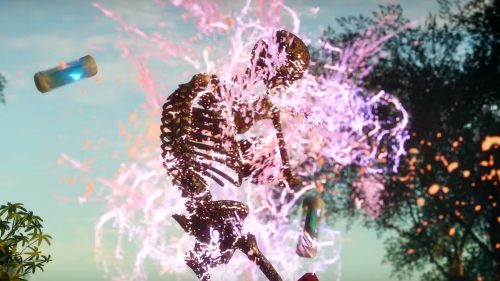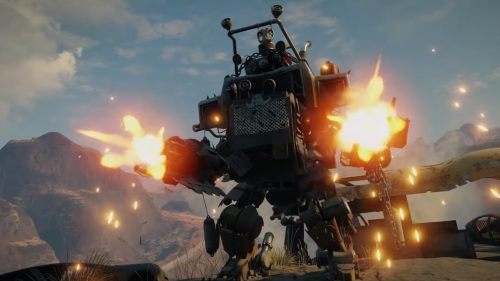RAGE 2 Review: Driving By, Shooting
About halfway through Rage 2’s unnecessarily protracted introductory mission, my enthusiasm for the id/Avalanche post-collaboration began to droop. Even for a tutorial level, it seemed linear and simplistic for a nominally open-world game. Surely it would get better soon, right?
Rage 2 might be the sequel to 2011’s Rage, but the developers (correctly) assume most players never played that game. So with an attention-grabbing cinematic, the status quo, villains, and stakes are afforded just enough time to make it clear what bad dudes you’ll be shooting. After an asteroid-impact apocalypse, some attempted to save humanity with “Arks,” but the Earth is now ruled by the cybernetic Authority, led by the rarely-seen General Cross and dedicated to “the surgical culling of the weak.” And as you become stronger, you'll be culling them.
None of this matters much. Once you pick a gender for your player character, Walker, Rage 2 turns its attention toward combat and stays there for the rest of the game. Walker picks up special armour from a “Ranger” (a paragon of heroism and justice the game never bothers to illustrate) who’s just had their head bitten off, and we’re off to the races. Before General Cross can be taken on, three key characters must be found and their development projects fulfilled. Welcome to Rage 2, and one of the dullest open worlds in the genre.
Post-Apophys Earth looks the part - if you don’t look for too long. Driving through the rugged landscape of canyons, deserts, swamps, and forests, the scenery looks fine. But “driving through” is about all you’ll ever be doing in this world, because the environment is as barren in gameplay as it is in design. The driving is well-tuned, as one expects from a game co-developed by Avalanche (of Mad Max and Just Cause fame), but the environment is random, constrained, and empty.
It’s not like there’s a lack of activities: by the time you’ve met the three principal NPCs, the map will be teeming with icons. But the activities they represent are incredibly repetitive - mostly variations on “kill this boss” or “kill these enemies” - and for the most part, painfully optional. The game invites you to engage with roaming patrols and convoys, but they’re merely annoyances on the road to better things. There are racing and arena-deathmatch activities, but they, too, feel like frivolous distractions. Trader towns offer little interest outside of item vendors. There’s little reason to get out of your vehicle except when arriving at your destination.
Rage 2’s dreary open world fades into the background once Walker gets into actual gameplay levels, however. There’s rarely as clear a delineation between collaborating studios’ contributions as here, where the open world is almost wholly Avalanche in flavour, and the levels contained within are very much id Software’s creation. A blend of corridor shooting, multi-level arenas, and creative makeshift architecture, many of Rage 2’s missions are vintage id, facilitating fast-paced shootouts using Walker’s arsenal and abilities. Though these make for fun setpieces, they also emphasise the odd sense that the game is made up of traditional levels connected by roads.
As for the action itself, it’s uniformly high-chaos, taking cues from 2016’s Doom reboot in how it incentivises bold forward momentum. Though medkits are available as pickups, they’re rare-ish and awkward to use, so the most effective way of maintaining health is to charge in and pick up the “feltrite” dropped by fallen enemies (which also serves as a primary currency). Rapidly-moving enemies demand rapid response, and many of the unlockable abilities, too, emphasise lurching towards enemies in order to debuff or damage them. The flow isn’t quite as smooth as in other recent Bethesda action games like Dishonored or Doom or Wolfenstein, but it’s fast and fun, with satisfying multi-purpose weapons and a tactile sense of “pop.”
As is the trend in action games these days, Walker’s abilities are a major focus. Traditional tricks like double-jump, melee attack, and dodge are granted neat additional twists, while more unique abilities give Walker forceful command over battlefields. The combo-centric Overdrive mode is almost comically overpowered, capable at its peak of making short work of nearly any enemy. And naturally, every ability can be upgraded in multiple directions, with many options yielding useful synergies with other abilities or items.
You’ll spend a lot of time poring over these details. Menus upon menus offer an unwieldy mess of unlockable upgrades and abilities, often drilling down multiple levels to get really specific about your character build. It’s an exhausting juggle of multiple currencies and countless risk/reward resource-investment decisions, exacerbated by menus cursed, on PlayStation at least, with an infuriating degree of input lag. Surprisingly, most upgrades actually feel significant - the power fantasy is strong, with little in the way of 5% health boosts - but sorting through the upgrade trees is horrendously complicated. And since the core abilities are initially unlocked through enjoyable (if repetitive) in-world missions, the menu metagame feels instantly stale.
Tonally, Rage 2 aspires to a freewheeling, chaotic sense of humour that blends the wildness of Mad Max, the absurdity of Fallout, and the bleakness of both. It doesn’t quite hit any of those targets. There’s plenty of winking bad-taste humour, delivered by a mostly cartoonish cast of wasteland weirdos, but it rarely feels organic to the world. Colourful punk raiders and grotesque mutants litter the landscape, but unlike other major post-apocalyptic titles, there’s little heart behind them, nothing to inform terrific names like “Nosebleed Kate” or “Hemmy Flanfinger”. Fallout and Mad Max care about their characters, whether innocents or monsters, but Rage 2 is populated exclusively with caricatures. They’re weird for the sake of weirdness, nasty for the sake of nastiness, with no truth behind them. It’s all the rote surface detail of the post-apocalyptic genre, with no depth or true idiosyncrasy.
All of this adds up to a game that’s short, repetitive, and hollow on a large scale, but that offers spectacular fun on a minute-to-minute basis. The almost structureless story cares not for rising and falling action, offering mostly a monodirectional training montage for its final mission. Is a world full of cookie-cutter activities still actually “full”? Is vehicular combat a feature when it’s a pain to engage in (with none of the Mad Max game's cinematic joy)? Do terrific shooting mechanics matter when the shooting is so frequently pushed aside? Rage 2 is a game of odd mechanical combinations and compromises, and like its predecessor, never quite finds its identity.
It certainly isn’t the go-for-broke punk-rock anarchy the marketing makes it out to be, despite the omnipresence of chugging guitars and pink mohawks.
Or maybe it is. But only for about ten seconds at a time.



